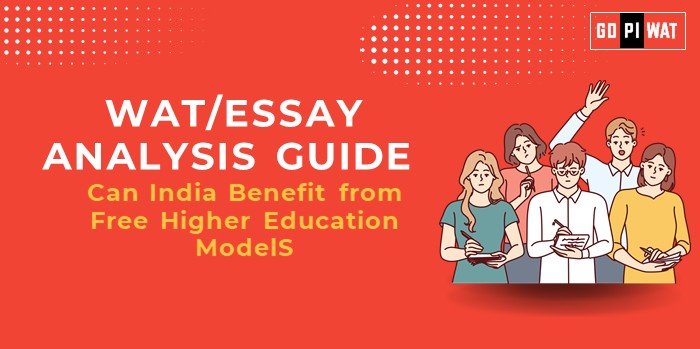📋 Can India Benefit from Free Higher Education Models?
🌐 WAT/Essay Analysis Guide
💡 Understanding the Topic’s Importance
Context: Free higher education models directly impact economic growth, social mobility, and workforce development. For India, implementing such models aligns with its broader goals of inclusive growth and skill enhancement for its young population.
⏳ Effective Planning and Writing
- 🕒 Time Allocation:
- 📝 Planning: 5 minutes
- ✍️ Writing: 20 minutes
- 🔍 Review: 5 minutes
- 📋 Preparation Tips:
- 📊 Note key statistics such as Gross Enrollment Ratio (GER) and budget allocation trends.
- 🤝 Understand the stakeholders: government, students, educational institutions, and policymakers.
💬 Introduction Techniques for Essays
- ⚖️ Contrast Approach: “While Nordic nations have successfully adopted free higher education, India struggles with equitable access amid rising education costs.”
- 🔧 Solution-Based Approach: “Addressing financial barriers in higher education could unlock India’s demographic dividend and spur long-term growth.”
- ⏳ Timeline Approach: “India’s higher education system has expanded rapidly over the last decade, yet affordability continues to hinder its true potential.”
📊 Structuring the Essay Body
🏆 Achievements:
- 📈 GER Improvement: India’s Gross Enrollment Ratio rose from 20% in 2010 to 27.3% in 2022, showing progress in higher education access.
- 🎓 Scholarships and Digital Platforms: Programs like NSP Scholarships and Swayam have improved access to education for marginalized groups.
⚠️ Challenges with Comparative Analysis:
- 💰 Financial Constraints: India allocates ~4.3% of GDP to education, while Germany invests over 6% to sustain free higher education.
- 🏫 Quality Disparities: Significant rural-urban gaps persist in institutional infrastructure and teaching quality.
- 🚸 Overcrowding: Public institutions face challenges like over-enrollment and lack of personalized resources.
🚀 Future Outlook:
- 💡 AI-Driven Learning Tools: Leveraging technology can reduce costs and enable scalable, quality education.
- 📜 Policy Interventions: Introduce a mix of income-based subsidies and targeted funding for underprivileged groups.
- 🌐 Public-Private Partnerships: Collaborations with private entities can enhance educational infrastructure while sharing costs.
✅ Concluding Effectively
- ⚖️ Balanced Conclusion: “Free higher education is a noble goal, but its implementation must be incremental to ensure fiscal sustainability while promoting accessibility.”
- 🌍 Global Comparison Conclusion: “India can learn from Nordic nations and tailor customized solutions to meet its unique socio-economic challenges.”
📊 Analyzing Successes and Shortcomings
- ✨ Key Achievements:
- 📈 Improved literacy rates and Gross Enrollment Ratios.
- 🎓 Increased focus on skill development through targeted scholarships.
- ⚠️ Ongoing Challenges:
- 💰 Significant fiscal deficits could challenge large-scale implementation.
- 🏫 Overcrowding in public institutions risks quality dilution.
- 🌍 Global Context:
- 🇩🇪 Germany: Offers free higher education funded by higher public spending, balancing access and quality.
- 🇮🇳 India: Needs to innovate with income-based solutions while maintaining fiscal discipline.
💡 Recommendations for Sustainable Progress
- 📜 Income-Based Subsidies: Implement means-tested scholarships to ensure targeted benefits for underprivileged students.
- 🤝 Strengthen Public-Private Partnerships: Collaborate with private players to share costs and improve educational infrastructure.
- 💻 Expand Digital Learning: Use AI-driven tools and online platforms to reduce costs while ensuring quality education delivery.
📝 Sample Short Essays
🔹 Balanced Perspective:
“India’s higher education faces a dual challenge of access and quality. While free education can democratize access, fiscal realities demand a phased, targeted approach to ensure long-term sustainability and equity.”
🔹 Solution-Oriented:
“Free higher education, coupled with income-based subsidies and public-private partnerships, can balance inclusivity and fiscal responsibility, paving the way for equitable access and skill-driven growth.”
🔹 Global Comparison:
“Inspired by Germany’s funding model, India must adopt customized solutions, balancing affordability and infrastructure development to ensure equitable, quality education for all.”


